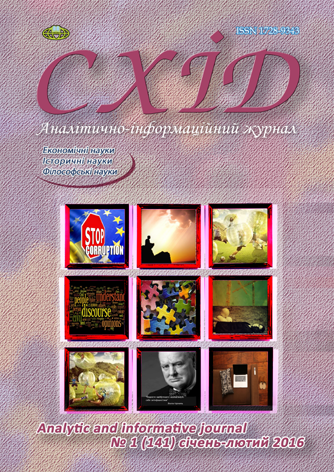Mining heritage and revalorization underground structures
DOI:
https://doi.org/10.21847/1728-9343.2016.1(141).64293Keywords:
revalorization, mining heritage, underground structures, mining historyAbstract
In the article the analysis of historical sources, the current state, problems and prospects revalorization of old buildings and underground mining sites in the world and in Ukraine. Examples of successful projects revalorization of old mining sites and create underground tourist trails. Formulated tasks for humanitarian and engineering areas on museification old mines and underground construction sites.
There is a problem of disparity of mineral resources major role in society and lack of attention to the information environment. There is great public interest modern and old mining industrial regions in preserving the historical heritage of old miners and underground structures. This requires systematic steps to save a few different times mining monuments that have survived. Methods and revalorization museification such facilities require a combination of humanitarian and engineering knowledge, including geoconstruction technology and global experience preserve these objects. In Ukraine, the preservation of industrial heritage by museification underground facilities is only some few attempts. There are interesting and promising projects that could be underground museum and tourist routes. They have the potential to promote technical knowledge. Musefication mining buildings - part of school and vocational higher education. Based on the possible establishment of mining museums in teaching and research centers. They contribute to the development of higher education institutions, domestic and international scientific tourism, promoting national brands in the world.
It is important that played industrial and urban monuments and museum exhibitions not only give an opportunity to get acquainted with the world of old buildings and technologies, but also revealed the inner spiritual world, traditions and cultural heritage of the ancient conquerors of underground space, carrying the best spiritual progress in the future.Downloads
References
Biletsky V. S., Gayko G. I. (2006), Chronology of mining in the world, Donetsk branch of the Shevchenko Scientific Society, "Editorial of Mining encyclopedia" UKTsentr, Donetsk, 224 p. (ukr).
Lynch M. (2004), Mining in World History, Reaktion Books,London, 350 p. (engl).
Fine B. (1990), The Coal Question: Political Economy and Industrial Change from the Nineteenth Century to the Present Day, Routledge,Chapman&Hall,New York, 218 p. (engl).
Saarbergwerke AG (1986), In der Geschichte graben. Was vermitteln uns Bergbaumuseen und Besucherbergwerke, Saarbrücken, 31 p. (ger).
Gayko G. I., Brovender Yu. M. (2007), Ways to humanization of mining and metallurgical education (experience of DonbassStateTechnicalUniversity), in: Yevrointehratsiya universytetskoi osvity ta nauky na shliakhu stvorennya suspilstva znan: Materials of International scientific and technical conference, Alchevsk, pp. 48-53 (rus).
Biletsky V. S., Gayko G. I. (2010), Musefication mining and problem study the history of mining in Ukraine, in: Tekhnichni muzei yak instrument zberezhennia istorychnoi spadshchyny i vazhlyvyi element rozvytku svitovoi tsyvilizatsii: materials of international Scientific and Practical Conference (2-3 June 2010), Donetsk, pp. 25-29 (ukr).
Gayko G. I., Biletsky V. S. (2013), History of Mining, Publishing house "Kyiv-MohylaAcademy", publishing house "Lado" DonSTU, Kyiv-Alchevsk, 542 p. (ukr).
Gayko G. I. (2009), The history of the development of the Earth's interior, East Publishing House,Donetsk, 292 p. (rus).
Encyclopédie, ou Dictionnaire Raisonné des Sciences, des Arts et des Métiers, available at: http://portail.atilf.fr/encyclopedie/ (french).
Biletsky V. S., ed. (2004), Mala hirnycha entsyklopediia [Small mining Encyclopedia in 3 volumes],Donetsk(ukr).
Karin Blent (2005), Skansen, Translated by http://www.worldcat.org/search?q=au%3AWising%2C+Larisa%2C&qt=hot_author">Larisa Wising,Stockholm, 146 р. (engl).
Brovender Yu. M., Gayko G. I. (2006), Kartamysh mining and metallurgical complex of the late Bronze Age, in: Skhid, № 6, pp. 69-73 (ukr).
Tekhnichni muzei yak instrument zberezhennia istorychnoi spadshchyny i vazhlyvyi element rozvytku svitovoi tsyvilizatsii. Materials of international Scientific and Practical Conference (2-3 June 2010), Donetsk, 156 p. (ukr).
Mikoś T. (2005), Metodyka kompleksowej rewitalizacji, adaptacji i rewaloryzacji zabytkowych obiektów podziemnych z wykorzystaniem technik górniczych, Uczelniane Wydawnictwa Naukowo-Dydaktyczne AGH, Kraków, 348 s. (pol).
Ivanytskyi Ye., Mykhalevych V. (1995), History Borislav oil area in dates, events and facts, Drohobych, 102 p. (ukr).
Mykulych O. (2004), The oil industry of Eastern Galicia to the middle of the XIX century, Drohobych, 32 p. (ukr).
Tiamin M. Yu. (2012), Scientific basis organization of park-museum of industrial culture (Skansen), in: Pratsi Tsentru pamyatkoznavsta, Issue 21, Kyiv, pp. 17-31 (ukr).
Denysyk H. I., Chyzh O. P. (2007), Museum of Industrial Culture of Podillia policies, in: Industrialna spadshchyna v kulturi i landshafti. Materials of Ukrainian scientific conference, 23-26 May 2007, Kyiv, pp. 178-180 (ukr).
Kazakov V. L., Kalinichenko O. O., Kulikovska O. Ye., Yarkov S. V. (2007), Industrial heritage of iron ore the mines "Chervony plast" city Kryvyi Rih, in: Industrialna spadshchyna v kulturi i landshafti. Materials of Ukrainian scientific conference, 23-26 May 2007, Kyiv, pp. 157-166 (ukr).
ChibonganMiningІnterpretationCenterChibongan, Quebec, Canada(2000), in: Architectural Record, № 1, pp. 130-132 (engl).
Horno-3: museo del Acero, Monterrey, Mexico, 2006-2007 (2010), in: Architecture now. Museums, pp. 162-163 (engl).
Downloads
Published
How to Cite
Issue
Section
License
Copyright (c) 2016 Gennadiy Gayko, Volodymyr Biletsky

This work is licensed under a Creative Commons Attribution-NonCommercial-NoDerivatives 4.0 International License.
1. Authors bear responsibility for the accuracy of facts, quotations, numbers and names used.
2. Manuscripts are not sent back.
3. The publisher does not always agree with the authors' opinion.
4. The authors reserve the right to authorship of the work and pass the first publication right of this work to the journal under the terms of a Creative Commons Attribution-NonCommercial-NoDerivatives 4.0 International License. This license allows others to distribute (copy) the published work for non-commercial purposes, provided there is mandatory attribution to its authors and a link to the first publication in our journal.
5. The authors have the right to conclude separate supplement agreements that relate to non-exclusive work distribution in the form in which it has been published by the journal (for example, to upload the work to the online storage of the journal or publish it as part of a monograph), provided that the reference to the first publication of the work in this journal is included.

